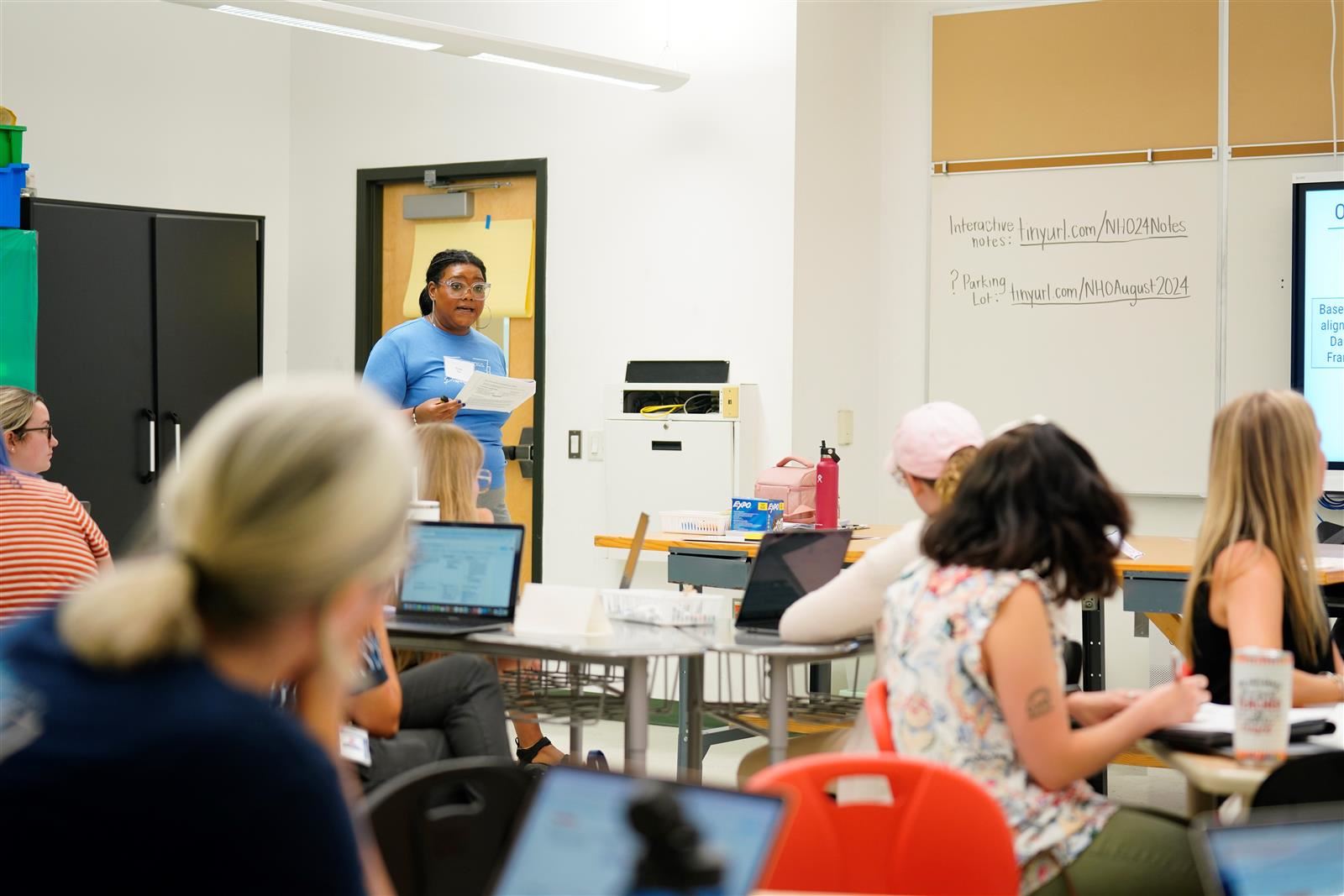- Council of the Great City Schools
- “Public Education Matters”
Digital Urban Educator - January/February 2025
Page Navigation
- Large City Schools Improve Faster than the Nation in Fourth-Grade Math
- Leaders from Guilford and D.C. Highlight Tutoring Programs in NAEP Webinar
- New Leaders Named in Milwaukee, St. Paul, and St. Louis; Fort Worth Selects Permanent Leader
- Council Offers STEM Scholarships to Urban Students
- Legislative Conference Begins in March
- “Public Education Matters”
- Memphis Teacher Named 2025 Grammy Music Educator of the Year
- Legislative Column
“Public Education Matters”
-
Federal COVID Recovery Dollars Fuel Philly’s Math Recovery
When The School District of Philadelphia officials learned in early 2023 that the district’s students were outpacing national pandemic recovery rates in math, they knew they had to sustain that momentum, and quickly.

Recognizing the power of a cohesive, districtwide curriculum and the importance of a consistent philosophy of teaching and learning mathematics, the district used $20 million in Elementary and Secondary School Emergency Relief (ESSER) funds to purchase new math instructional resources to be used by every school in the district, from kindergarten through 12th grade.
Implementation began in fall 2023.
The immediate district-wide scale-up to the new math instructional resource, Illustrative Mathematics, “was a bold move” by superintendent Tony Watlington, Sr., said Michael Farrell, the district’s chief learning officer.
Citing Watlington’s goal of making Philadelphia the fastest-improving big-city district in the nation, Farrell said the tendency of big-city school districts to initially pilot curricula in a small number of schools didn’t meet the sense of urgency the district felt.
“We had to ensure our students had the best materials right away,” Farrell emphasized. “A phased approach was out of the question for our superintendent.”
Watlington and district officials were also heeding the Philadelphia Board of Education’s goals for math student achievement: By school year 2029-30, 52 percent of 3rd through 8th graders must score at proficient or advanced level on the state math assessment; 57.5 percent of 3rd graders must score at proficient or advanced level on the same assessment; and 53 percent of students must score at proficient or advanced level on the state’s algebra assessment.
Farrell also underscored the importance of curricular stability for teachers and students who transfer from one district school to another. Having the same instructional resource in every district school means students who transfer to another school have a seamless learning experience.
“It also helped us align all of our professional development and coaching supports…and train and scale everyone up at the same time,” he said.
Rigorous process used to select new math materials
Although the district’s implementation schedule has been swift, Nyshawana Francis-Thompson, the district’s chief of curriculum and instruction, emphasized that the decision to purchase new math instructional resources was rooted in four years of careful study of what was needed to boost student learning and the role of instructional materials in such efforts.
“This was no overnight story,” Francis-Thompson said, citing a 2019 Philadelphia Board of Education-sanctioned audit by the Council of the Great City Schools as the catalyst for the new math materials.
“At the heart of the challenge [in improving student learning] was the curriculum,” she explained.
During the last decade, the district had moved away from a centralized curriculum, with as many as three different sets of instructional resources being used across the district. So it was crucial, Francis-Thompson said, for the district to focus on providing its teachers and students with high-quality instructional materials.

Equally important, she said, was engaging parents, teachers, and school leaders in “a five-phase” materials selection process. The district started by inviting students, parents, teachers, and school leaders to stakeholder engagement sessions to learn what they wanted in high-quality instructional materials. Next was a request for proposals that included a 3-day vendor conference in the district office so prospective vendors could share materials with stakeholders. The district followed the conference with an expert content review, during which experienced teachers certified in math reviewed and scored all proposals and materials and benchmarked them against instructional materials reviews by highly regarded EdReports.
Final materials selection involved website postings and presentations to the Philadelphia Federation of Teachers, the principals union, and the district’s chief officers, before a final presentation to the Philadelphia Board of Education.
“It was a very rigorous process…to get to these high-quality materials…very extensive,” Francis-Thompson said.
Supporting school leaders and teachers in understanding and using the new math materials would be critical to successful implementation, said Farrell, who oversees professional learning for the district. So, Farrell and his staff set a regular cadence for existing school-level professional learning communities, hired external coaches familiar with the materials to bring district coaches up to speed, and established teacher advisories to provide direct implementation feedback to Farrell and his team.
“We knew we were not experts in this instructional resource yet,” Farrell said, underscoring that “it was important to give grace to teachers” as they made sense of new math materials and teaching methods “and to model for them that we were learning as well.”
Students make progress in math
The Philadelphia school system, which in December 2024 committed another $25 million to support the new instructional materials, is already reporting gains in math student achievement. Most significant, Francis-Thompson said, were achievement boosts on mid-year assessments during the first year of implementation.
The mid-year boosts are notable, Francis-Thompson said, because “typically in year one (of implementation), you see a dip, but we…saw students progressing,” she explained.
Lauren Overton, principal of Penn Alexander School, points to another area of success for her students and teachers, as a result of the new math materials.
“We’re most proud that [Illustrative Mathematics is] helping us decrease the opportunity gap for historically marginalized students,” she said, citing growth among all student groups, from students with Individualized Education Plans (IEPs) and multilingual learners to students of color and those from low-income backgrounds.
Overton added that working with the new materials has both enhanced her teachers’ instructional teaching approaches and radically changed how Penn Alexander students position themselves as math learners.
“There’s a lot of language in these materials that gets students to notice and wonder before jumping into problem-solving…and that there are multiple ways to think about problem-solving and many pathways to getting to an answer,” Overton said. This approach, she added, leads to a conceptual understanding of mathematics and its real-world functions.
Kayla Gay, who teaches sixth grade at Cook Wissahickon School, lauded instructional routines such as discussion supports for helping all of her students, especially those who are English language learners and students with learning disabilities, get more comfortable with discussing math in the classroom.
Gay described a routine embedded in the materials that asks the students to follow along while the teacher reads a discussion prompt three different times, each time asking different questions to gauge student understanding from basic comprehension to considering what do the units and numbers indicate in the problem, and finally putting it together to develop the knowledge needed to begin solving the math problem.
“It sets them off on the right foot, especially for my special education students who need additional help in figuring out where to start,” she said.
Federal funding played a pivotal role
Farrell said federal funding that the district used to purchase Illustrative Mathematics and coaching support for the district’s math teachers “was pivotal” for the large-scale improvement effort.
“High-quality learning materials matter,” he said, but “schools don’t have this bucket of surplus money they can [use].”
Federal funding also helped the district build what Francis-Thompson called “a multipronged approach” to sustain post-pandemic student math gains, which includes high-impact tutoring to provide additional support to students in eight of its schools, and a multiyear strategy focused on expanding access to and acceleration in algebra from kindergarten through Grade 12.
“Federal money is critical to districts like ours that are historically underfunded to ensure we’re meeting the needs of our young people,” she said.
Denise Walston, chief of curriculum for the Council, said Philadelphia’s experience highlights the importance of investing in high-quality materials, along with ongoing professional development to help teachers effectively use those materials to meet grade-level or course expectations.
“Additionally, job-embedded coaching for teachers plays a crucial role,” said Walston. “Philadelphia’s investment in these key supports has contributed to successful implementation."
Media Contact:
Contact Name
Contact@email.com
(000) 000-0000
Contact Name
Contact@email.com
(000) 000-0000
Contact Name
Contact@email.com
(000) 000-0000
Media Contact:
Contact Name
Contact@email.com
(000) 000-0000
Contact Name
Contact@email.com
(000) 000-0000
Contact Name
Contact@email.com
(000) 000-0000


